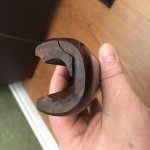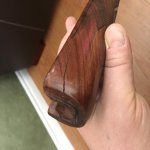You are using an out of date browser. It may not display this or other websites correctly.
You should upgrade or use an alternative browser.
You should upgrade or use an alternative browser.
Worth trying to fix? Marlin 1895 GS split forearm
- Thread starter DIGGER2
- Start date
I've never used Zap a Gap - never heard of it - but I am sure a near invisible repair could be made with good epoxy.
Agreed!! I have had repairs done to wood stocks that were in far worse shape than that.
vagrantviking
CGN Ultra frequent flyer
- Location
- High River, Alberta
It depends a bit on why it cracked.
The way it gapes open it looks like there was a lot of stress in the wood from shrinkage. If that's the case and you clamp to glue it might just split again nearby. You would be better off filling the crack or maybe a creative inlay.
For the lip that goes under the nose cap you might want to carve some wood out of the inside, glue a new piece in and reshape to match the existing side. Going to be a bit of work though so it depends on how much trouble you want to go to or the cost of a replacement.
The way it gapes open it looks like there was a lot of stress in the wood from shrinkage. If that's the case and you clamp to glue it might just split again nearby. You would be better off filling the crack or maybe a creative inlay.
For the lip that goes under the nose cap you might want to carve some wood out of the inside, glue a new piece in and reshape to match the existing side. Going to be a bit of work though so it depends on how much trouble you want to go to or the cost of a replacement.
,
I would try a repair first to make a usable rifle, but it would not hurt to see if you could fine a replacement forestock. That is a kind of nice piece of wood.
One thing I do with cracked stocks (if you can), is to use a heavier staple that is used for construction. These come in various widths. If you have an area that does not show, you can take one staple, and drill two slightly smaller holes in the end of the forestock. Make these holes the width of the length between the points of the staple, Then, using a Dremel with a thin blade or a thin wood chisel, cut out a channel that connects these holes. The channel does not have to be deep, but it should be deep enough so that the staple is recessed when you drive it in.
Apply some epoxy glue to the crack, the two holes you drilled, and some in the channel you cut, then drive the staple in. Try to clamp the cracked pieces together if you can, and the staple can also be put in after you have glued the cracked pieces together. Coat the channel with a bit of epoxy glue, and the staple will act as a tie or reinforcement, and be out of sight .
Heavy rubber bands work for holding the pieces together, but I prefer surgical rubber tubing. You can use different lengths and tie it easily.
In this case, I would think about using two staples, one for the side and one at the bottom, possibly angled a bit on the bottom one.
I would try a repair first to make a usable rifle, but it would not hurt to see if you could fine a replacement forestock. That is a kind of nice piece of wood.
One thing I do with cracked stocks (if you can), is to use a heavier staple that is used for construction. These come in various widths. If you have an area that does not show, you can take one staple, and drill two slightly smaller holes in the end of the forestock. Make these holes the width of the length between the points of the staple, Then, using a Dremel with a thin blade or a thin wood chisel, cut out a channel that connects these holes. The channel does not have to be deep, but it should be deep enough so that the staple is recessed when you drive it in.
Apply some epoxy glue to the crack, the two holes you drilled, and some in the channel you cut, then drive the staple in. Try to clamp the cracked pieces together if you can, and the staple can also be put in after you have glued the cracked pieces together. Coat the channel with a bit of epoxy glue, and the staple will act as a tie or reinforcement, and be out of sight .
Heavy rubber bands work for holding the pieces together, but I prefer surgical rubber tubing. You can use different lengths and tie it easily.
In this case, I would think about using two staples, one for the side and one at the bottom, possibly angled a bit on the bottom one.
nomad 68
CGN Ultra frequent flyer
Now there's a new level of ugly for ya lol.
vagrantviking
CGN Ultra frequent flyer
- Location
- High River, Alberta
Now that's the most fugly hideous thing I've seen in a very long time!
Thanks for all your help guys, I’m far from being a master craftsman with wood. I’ve currently used Gorrilla wood glue to put the crack together but may take the suggestion of using some staples or pins to further strengthen the crack. The next option is to just replace the forearm with a new one. Thanks again for all your guys help, it’s much appreciated.
I would fix that forestock for sure. Since you've already glued the crack, you can still reinforce the repair. The old gunsmiths used to drill a hole into crack just past the split and insert a piece of small brass rod or pin. You can do the same by drilling a small hole from the top and screwing a small brass #5 or #6 screw into the crack. Leave the head exposed and cut it off. Dress the remaining screw end flush with the top of the stock. The fore-end cap with likely cover the screw end but if not, it's not really a problem either.
https://www.homedepot.com/p/6-x-1-1-2-in-Phillips-Brass-Flat-Head-Wood-Screws-2-per-Pack-809621/204275722
https://www.homedepot.com/p/6-x-1-1-2-in-Phillips-Brass-Flat-Head-Wood-Screws-2-per-Pack-809621/204275722
I've never used Zap a Gap - never heard of it - but I am sure a near invisible repair could be made with good epoxy.
Gap filling formulation of CyanoAcrylate glue. Zap is the product line 'brand', most of the makers of CA glues offer similar.
Good stuff, not as instant as the thinner stuff, but does not wick in to tight cracks as well either.
From the looks of it, the grain of that forend is not really appropriate for it's intended purpose.
Would be a good idea to find a router and jig it up to carve away the remains of the flange which went under the edge of the action, and glue in a section of straight grained wood to replace that. The inset piece will not be visible and the repair will be strengthened by having an additional piece of wood with the grain not running same as the forend.











































































